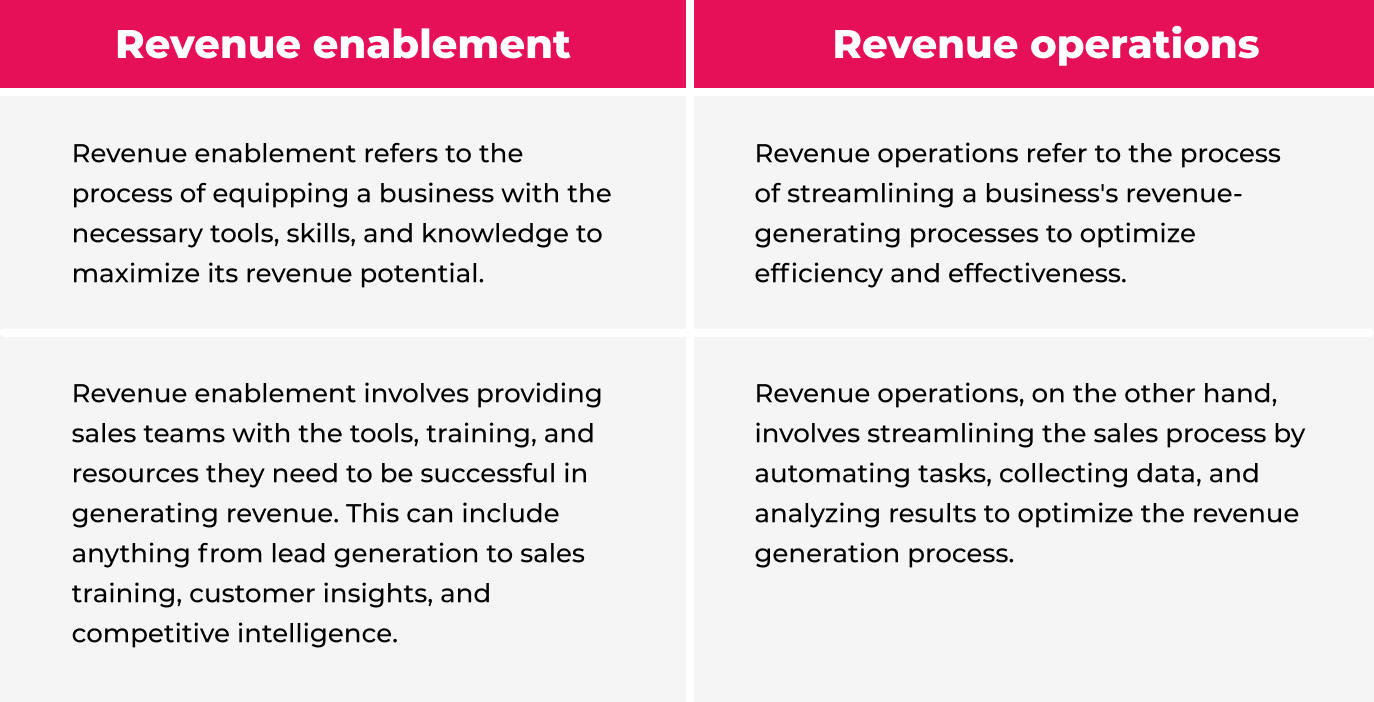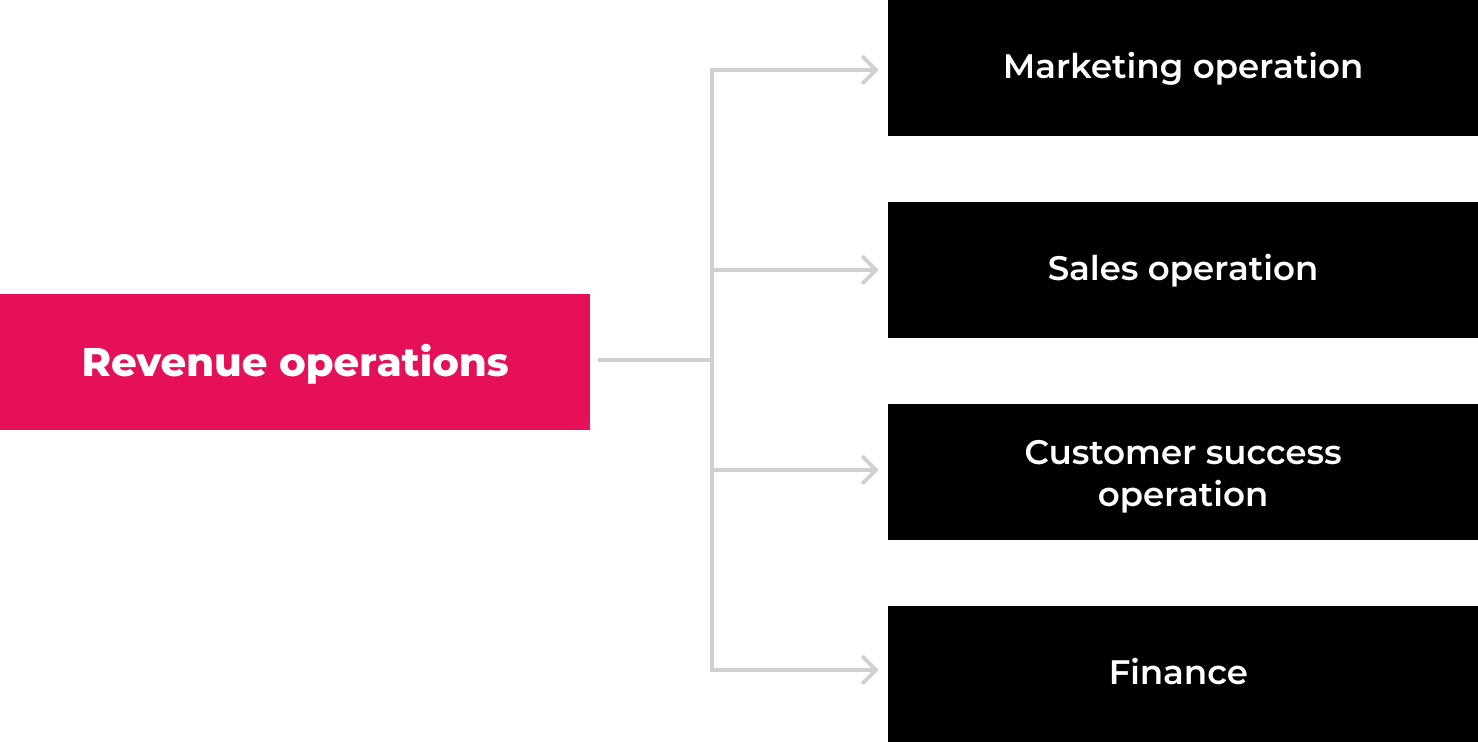Revenue Enablement and Operations: Taking a Deeper Look
Revenue enablement and operations can help organizations streamline their revenue generation efforts and improve their bottom line.
Revenue enablement is the process of equipping sales teams with the knowledge, skills, and tools they need to maximize revenue generation. It involves aligning sales, marketing, and customer success functions to create a cohesive revenue engine.
Operations, on the other hand, is focused on optimizing processes and systems to support business growth. Integrating revenue enablement and operations can help organizations streamline their revenue generation efforts and improve their bottom line.
Explanation of Revenue Enablement and Operations:
Revenue enablement refers to the process of equipping a business with the necessary tools, skills, and knowledge to maximize its revenue potential. Revenue operations, on the other hand, refers to the process of streamlining a business's revenue-generating processes to optimize efficiency and effectiveness.
Both revenue enablement and operations are vital components of a business's revenue-generating strategy.
Importance of Revenue Enablement and Operations:
Revenue enablement and operations play a crucial role in a business's success. They help businesses achieve their revenue goals by equipping them with the necessary tools, strategies, and processes to maximize their revenue potential.
Revenue enablement and operations also help businesses identify and address areas where revenue is leaking or being lost, which can significantly impact a business's bottom line.
In the following sections, we will discuss revenue enablement, revenue operations, and how businesses can integrate the two to maximize their revenue potential. We will also outline the best practices for revenue enablement and operations, successful integration strategies.

Revenue Enablement:
Revenue enablement refers to the process of equipping a business with the necessary tools, skills, and knowledge to maximize its revenue potential. Revenue enablement is all about empowering a business to generate more revenue through effective sales and marketing strategies, enhanced customer engagement, and better communication.
Here are some of the benefits of revenue enablement:
Benefits of Revenue Enablement:
- Enhanced customer engagement and experience
- Increased revenue and profitability
- Better alignment between sales and marketing teams
- Improved sales productivity and efficiency
- Better customer insights and data-driven decision-making
- Increased employee engagement and job satisfaction
- Better market positioning and competitive advantage
Examples of Revenue Enablement Strategies:
- Sales and marketing alignment
- Customer-centric sales and marketing strategies
- Content marketing and thought leadership
- Sales enablement technology and tools
- Sales coaching and training
- Cross-functional collaboration
- Customer feedback and insights
Revenue Operations:
Revenue operations refer to the process of streamlining a business's revenue-generating processes to optimize efficiency and effectiveness. Revenue operations are all about creating a seamless revenue generation process that maximizes revenue potential while minimizing waste, inefficiencies, and delays.

Here are some of the benefits of revenue operations:
Benefits of Revenue Operations:
- Better sales pipeline visibility and management
- Enhanced sales forecasting and revenue predictability
- Improved lead-to-customer conversion rates
- Faster time-to-revenue
- Enhanced customer data management and insights
- Streamlined sales processes and operations
- Increased sales and marketing efficiency
Examples of Revenue Operations Strategies:
- Sales process automation
- Sales pipeline management and forecasting
- Sales and marketing analytics
- Data management and governance
- Sales and marketing technology integration
- Sales process optimization
- Sales performance management
Integrating Revenue Enablement and Operations:
Revenue enablement and operations are closely related and interdependent.
Integrating Revenue Enablement and Operations
Revenue enablement and operations are two critical components of any organization's revenue strategy. While they may appear to be separate entities, they are closely related and can work together to maximize revenue potential.
Revenue enablement involves providing sales teams with the tools, training, and resources they need to be successful in generating revenue. This can include anything from lead generation to sales training, customer insights, and competitive intelligence.
Revenue operations, on the other hand, involves streamlining the sales process by automating tasks, collecting data, and analyzing results to optimize the revenue generation process.
When these two functions work together, they can create a powerful revenue engine for an organization. Revenue enablement provides the sales team with the insights and knowledge they need to close deals, while revenue operations ensures that the process is streamlined and efficient.
Benefits of Integrating Revenue Enablement and Operations
The integration of revenue enablement and operations can lead to several benefits, including:
Improved Collaboration: When revenue enablement and operations work together, they can better align their goals and objectives, leading to improved collaboration and communication between teams.
Increased Efficiency: By automating tasks and streamlining the sales process, revenue operations can help sales teams work more efficiently, allowing them to focus on generating revenue.
Better Insights: Revenue enablement can provide sales teams with valuable insights into customers, competitors, and industry trends, helping them to close deals more effectively.
Increased Revenue: Ultimately, the integration of revenue enablement and operations can lead to increased revenue for an organization by improving the sales process and providing sales teams with the tools they need to be successful.
Examples of Successful Integration Strategies
There are many ways to integrate revenue enablement and operations, and the best approach will depend on an organization's specific needs and goals.
Some successful integration strategies include:
Collaborative Planning: Revenue enablement and operations teams can work together to develop a comprehensive revenue plan that aligns with the organization's overall goals and objectives.
Joint Training: Revenue enablement can work with revenue operations to provide sales teams with training on the latest tools and techniques for generating revenue.
Data Sharing: Revenue operations can collect and analyze data on the sales process, which can be shared with revenue enablement to provide valuable insights into customer behavior and preferences.
Ongoing Communication: Regular communication between revenue enablement and operations teams can ensure that they are working together effectively and making the most of their respective strengths.
Best Practices for Revenue Enablement and Operations
To ensure the success of revenue enablement and operations, organizations should follow these best practices:
Develop a Comprehensive Plan: Revenue enablement and operations teams should work together to develop a comprehensive revenue plan that aligns with the organization's overall goals and objectives.
Use Data to Drive Decisions: Revenue operations should collect and analyze data on the sales process to identify areas for improvement and make data-driven decisions.
Provide Ongoing Training: Revenue enablement should provide sales teams with ongoing training on the latest tools and techniques for generating revenue.
Foster Collaboration: Revenue enablement and operations teams should work together closely and regularly communicate to ensure that they are aligned and making the most of their respective strengths.
Conclusion:
Revenue enablement and operations are critical for the success of any business, and Paperflite offers an array of features that can help businesses achieve their revenue goals. With Paperflite's content management and tracking capabilities, businesses can create, organize, and distribute content to their sales teams, ensuring that they have the right content at the right time.
Additionally, Paperflite's advanced analytics provide valuable insights into how sales teams are interacting with content, helping businesses identify areas for improvement and optimize their sales process.
Paperflite's platform also offers integrations with popular CRM and marketing automation tools, streamlining the revenue generation process and reducing manual tasks. Together, these features make Paperflite a powerful tool for revenue enablement and operations, helping businesses drive sustainable growth and profitability.
Get Granular Information About Every Content Being Sent
FAQ's
What technologies are commonly used in revenue operations?
Revenue operations teams often use a variety of technologies to streamline their operations and improve performance. These may include CRM software, marketing automation platforms, data management tools, analytics software, and more.
How does revenue operations differ from traditional sales operations?
While traditional sales operations focuses primarily on optimizing the sales process, revenue operations takes a more holistic approach to revenue generation across all functions, including sales, marketing, and customer success. Revenue operations teams work to ensure that all revenue-generating departments are aligned and working towards common goals.
What skills are important for revenue operations professionals?
Professionals in revenue operations should have a strong understanding of sales, marketing, and customer success, as well as experience working with data analytics and technology. Additionally, communication and collaboration skills are crucial for working across departments and ensuring alignment.
How can revenue operations be integrated into an organization?
Integrating revenue operations into an organization requires a top-down approach, with leadership buy-in and clear goals established for the team. Collaboration and communication between revenue-generating departments is also crucial. Organizations should also invest in the right technologies and data management processes to support revenue operations initiatives.
What are some common challenges faced by revenue operations teams?
Some common challenges faced by revenue operations teams include data quality issues, misalignment between departments, and a lack of visibility into key performance metrics. It's important for revenue operations teams to address these challenges proactively and work to improve processes and communication across the organization.
